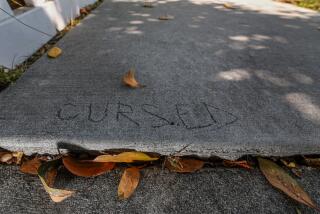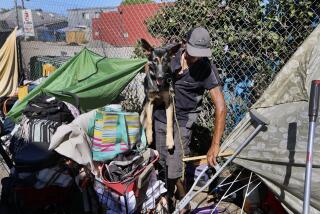Staking turf by snowy curbs
- Share via
CHICAGO — With snow expected to snarl the roads and cover cars here over the next few days, the cold-weather battle over Windy City street parking will kick into high gear.
Residents will pick up their shovels, clear their curbs of powder and ice -- and then line their stretch of the street with lawn chairs.
Or sawhorses. Dinette sets. Bar stools. Flowerpots.
Even empty cardboard boxes and rusty metal buckets will litter the roads, all in a bid to ward off drivers who might steal the cleared space.
It’s an unwritten law, particularly in the densely populated neighborhoods that have gentrified as part of this city’s ongoing urban revival: If you shovel it, you own it. And woe be to anyone who moves such items while the spot’s “owner” is away.
“You could put a television set out there and no one would touch it,” said Wendy Pastrick, 36, a database administrator whose family keeps a bright-orange construction cone next to the snow shovel on the front steps.
Across the street, two houses had folding chairs leaning against snow shovels. Down the block, two more homes had white plastic chairs nestled amid the shrubs and bags of de-icing salt.
Those who do dare move such items and claim a stretch of curb they didn’t clear could see their normally friendly neighbors turn into vigilantes who dole out justice by breaking windows, scratching paint and slashing tires.
The tradition of guarding parking spaces is not without its critics.
“It’s pathetic,” said Eric Zorn, a metro columnist for the Chicago Tribune who has railed against the practice -- to friends, neighbors and in print -- for years.
“I feel some sympathy when we really get walloped and it takes so long to shovel the street. But what we’ve had this winter so far, shoveling a few inches of snow, is no reason to stake a claim on a public street.”
As snowplows crawl through the city’s main arteries and crisscross its neighborhoods, they leave behind thousands of miles of cleared streets -- and cars trapped by piles of dirty snow.
Owners digging out their vehicles often create a patch of cleared blacktop with mounds of icy excess tossed into the gaps at the front and back of their cars. Those leftover piles of snow eat up valuable curb space and reduce the amount of overall parking.
Hauling out garage-sale junk from the basement soon follows. So do the neighborhood skirmishes.
Michael Weber has learned his lesson, he said. The 37-year-old bartender used to ignore the parking-dibs tradition.
Then, one snowy night three years ago, after spending a fruitless half-hour circling his Andersonville neighborhood for a parking spot, he decided to nudge an orange cone out of the way.
“The next morning, the side mirror of my Explorer was cracked,” said Weber, whose north-side neighborhood is an enclave for young professional families that prefer city living to the suburbs. When he complained to some of his neighbors, he said, “they said I was being punished for being lazy.”
Though the city doesn’t officially condone the practice, Democratic Mayor Richard M. Daley has voiced support for shovelers in the past. In a town where life is commonly seen through a political lens, few things get voters more riled than a politician who lets a little thing like weather slow down the city that works.
The infamous blizzard of 1979, in fact, was blamed for contributing to Democratic Mayor Michael Bilandic’s losing his reelection bid. Bilandic had suggested that Chicagoans park their cars in school lots that were never plowed, and had bragged about how efficiently O’Hare International Airport was operating -- when the airport was actually shut down.
Other sometimes-snowbound metropolises, such as New York, wrestle with similar debates. In Boston, Democratic Mayor Thomas Menino is enforcing a rule that lets people reserve a spot for 48 hours after a heavy snow. After that, the items must be removed -- or the city will take the stuff, said mayoral spokeswoman Dot Joyce.
“We don’t want to cheat people who put the work in,” Joyce said. “But when we have 50-degree weather and there’s no snow left on the curb, and people are still putting cones out on the street? No. We expect people to use their common sense.”
How the tradition began in Chicago is unclear, though it dates back decades. Matt Smith, a spokesman for the city’s Department of Streets and Sanitation, recalls walking through snowdrifts as a child after the 1967 blizzard, and seeing neighbors plop down kitchen chairs in freshly cleared streets.
“We’re tolerant of it, to a degree, because during a Chicago snowstorm we have far bigger fish to fry,” said Smith.
Still, he pointed out, his department recently told residents to move their motley place-holders after the snow had melted. Many people acquiesced, pulling items off the street and onto their porches, for easy access when the next storm arrives.
Weber is now a parking-dibs convert.
As the first flakes began to fall Friday morning, he raced outside his two-story brick home with a broom to clear the lightly dusted road.
Then he started picking out his markers: a traffic cone and a doll from an outdoor Nativity scene.
“I figured no one’s going to move Baby Jesus,” said Weber, as he placed the life-size figurine and manger next to the street. “Even if you’re tired and cold, people will have some respect.”
--
More to Read
Sign up for Essential California
The most important California stories and recommendations in your inbox every morning.
You may occasionally receive promotional content from the Los Angeles Times.













